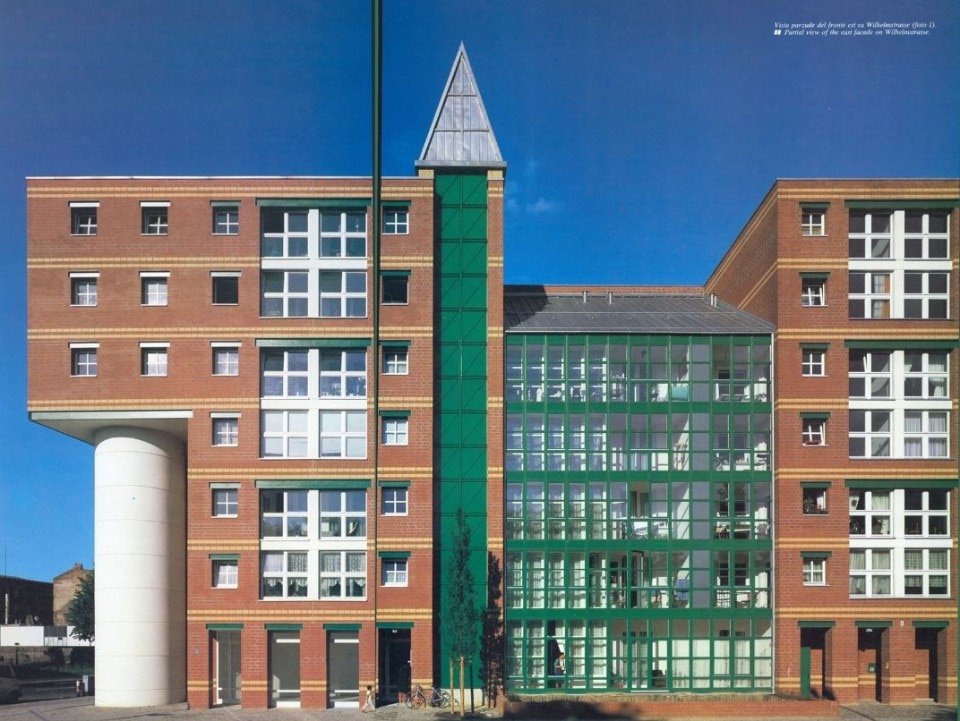“The problem of building in Berlin and of building a block in the centre of Friedrichstadt concerns the architecture of a city”. In the context of IBA 1987 – Internationale Bauausstellung, the urban-scale building exhibition creating new residential buildings and open spaces intended to redefine new centralities and forms mainly in the historic fabric of West Berlin – Aldo Rossi with Gianni Braghieri had won the competition for a block back in 1981, and then focused on the development of lot 10, in the southern quadrant of Friedrichsstadt. The project became one of those operative expressions of the theoretical, urban and typological reflections that had placed Rossi in a distinct position in the Italian and international architectural debate, soon an icon of the translation into built form of his designs, destined to be received as a style. Domus published its images and report in September 1988, issue 697, with a clear investigative purpose: “All the themes on the form of the city that have characterized the work of Aldo Rossi are distinctly clarified here in Berlin. Translated into concrete form are the limit and the interest of his architecture”.
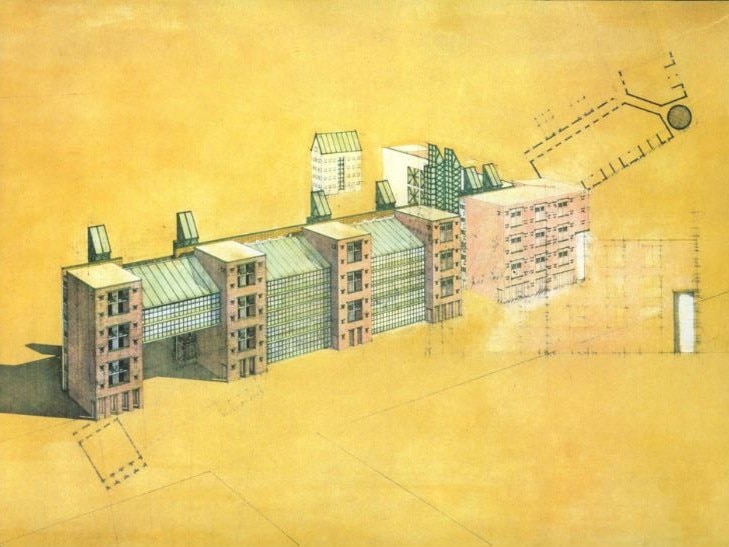
Aldo Rossi, Residential Building, Südliche Friedrichstadt, Berlin
The architecture of Berlin
The problem of building in Berlin and of building a block in the centre of Friedrichstadt concerns the architecture of a city. This means that personal invention, and architecture of quality but only on a private scale, are of no purpose to the architectural and urban problems of the metropolis. Even Hegemann criticizes the great Schinkel for not having interpreted the urban problems of Berlin in a unitary project; and he cites Weinbrenner who, without attaining the greatness of Schinkel, laid out an urban project in which architecture was part of the city’s general design.
There is no doubt that Schinkel’s buildings suggest a city made for monuments and represent a part of Berlin which has to be taken into account for its architectural character; but they do not represent a built continuity. And yet, in his letters from England the great German architect foresees, even if he does not understand or seems not to understand, the future of the city; his opinion of English houses, although unfavourable, reveals a deep interest and gives a description that is almost a reconstruction.
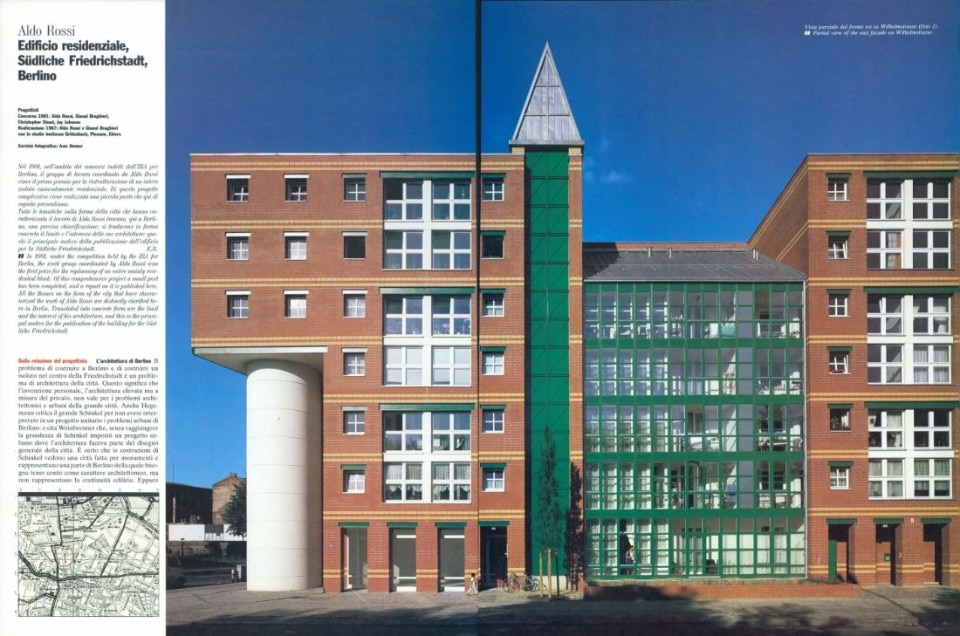
In actual fact that type of red brick house, marked by windows, was to become the modern industrial city, and Berlin itself. The Paris of rue de Rivoli was to make way for the Paris of Haussmann. But those examples of grand unitary schemes remained fundamental to the modern city, and they serve as a reference now too, for a new vision of the city, made of different pieces and each with its own architectural character. On the other hand, despite Hegemann’s correct criticisms of Friedrich Wilhelm’s planning policy, it remains significant that the king had drawn the plan of Friedrichstadt with a set-square, without paying the slightest attention to the difficulties of the site; and that he had had the idea of putting large squares at the end of these streets. That the squares, though following the French example, are inferior to it does not seem to me to be a fair objection.
In reality the Belle-Alliance-Platz, as passed down to us in the famous 18th-century painting, is, together with some of Schinkel’s and Weinbrenner’s works, with Ludwig’s Munich and with the paintings of C D . Friedrich, among the most distinctive and original experiments of German culture and among those that were to have the biggest influence in modern art.
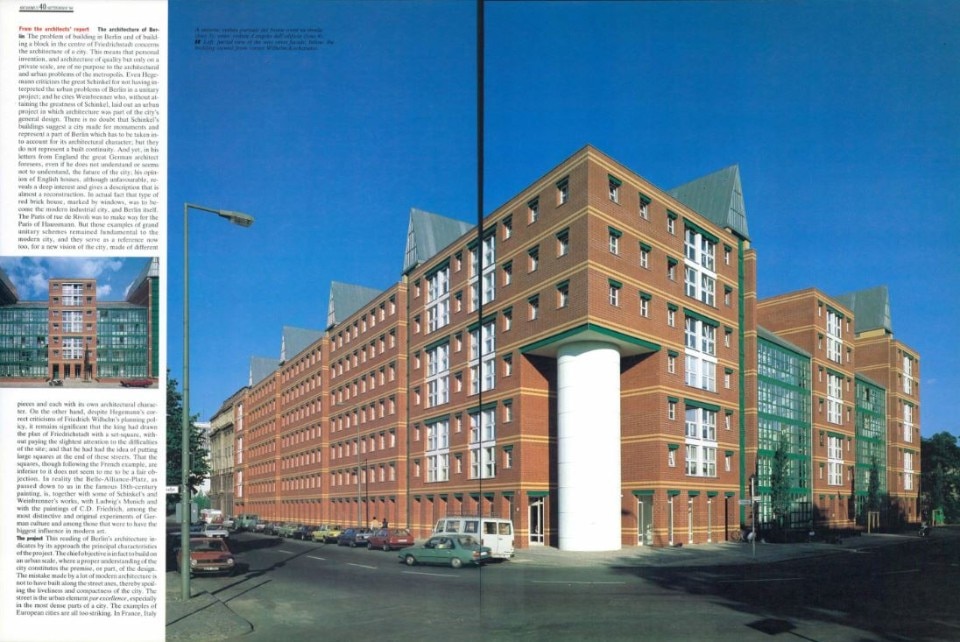
The project
This reading of Berlin’s architecture indicates by its approach the principal characteristics of the project. The chief objective is in fact to build on an urban scale, where a proper understanding of the city constitutes the premise, or part, of the design. The mistake made by a lot of modern architecture is not to have built along the street axes, thereby spoiling the liveliness and compactness of the city. The street is the urban element par excellence, especially in the most dense parts of a city. The examples of European cities are all too striking. In France, Italy and Spain, arcades were built across parts of cities. The Galleria Vittorio Emanuele in Milan, criticized by the architects of the Modern Movement, is today universally recognized as one of the most significant examples of the union between city and architecture, and indeed of urban architecture.
The first aim of the project was therefore to respect the street alignment by building along the perimeter of the area and thus to re-establish Friedrichstadt. Where this principle has not been followed the result has always been a failure. This is demonstrated in Berlin itself by Hansa Viertel, nor is the good architecture enough to redeem the mistaken basis.
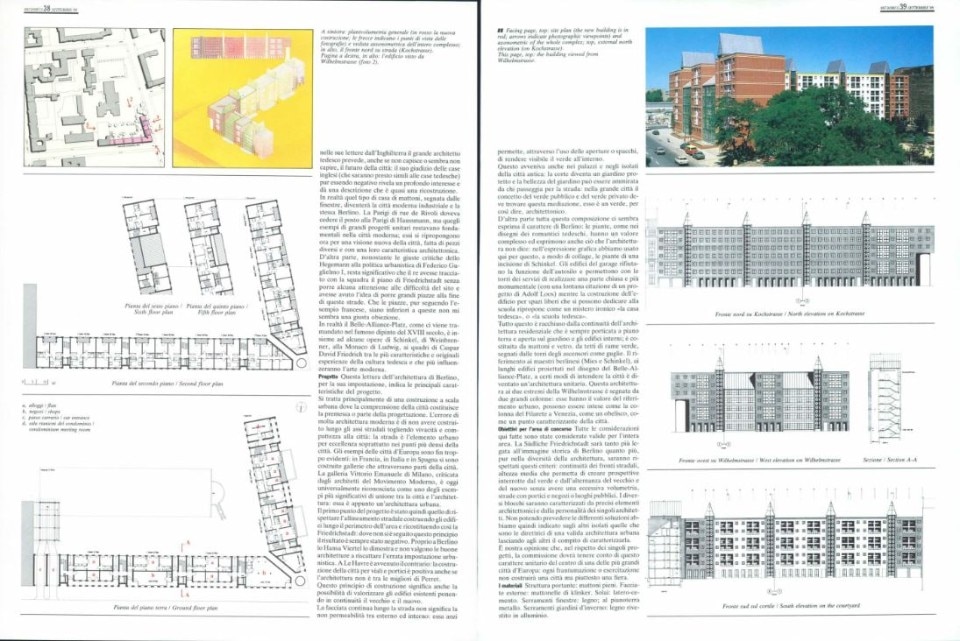
This principle of planning also means the possibility of enhancing existing buildings by continuing the old with the new. The continuous facade along the street does not entail an impermeability between exterior and interior: on the contrary it makes it possible, through the use of apertures or gaps, to make gardens and greenery visible from inside. This also happened in the buildings and blocks of the old city. The courtyard becomes a protected garden and the garden’s beauty can be admired by people walking along the street. In the big city the concept of public and of private gardens has to be mediated in this way, becoming, so to speak, an architectural garden.
For that matter the whole of this composition seems to me to express the character of Berlin: the trees, as in the drawings of the German romantics, have a complex value and also express what the architecture does not say. In the drawings graphic expression we have for this reason used the plants from an engraving by Schinkel. The garage buildings refuse the function of tower-garages and make it possible by their service towers to achieve a closed and more monumental part while the construction of the building by free spaces that can be dedicated to the school reintroduces as an ironic mystery “the German house”, or “the German school”.
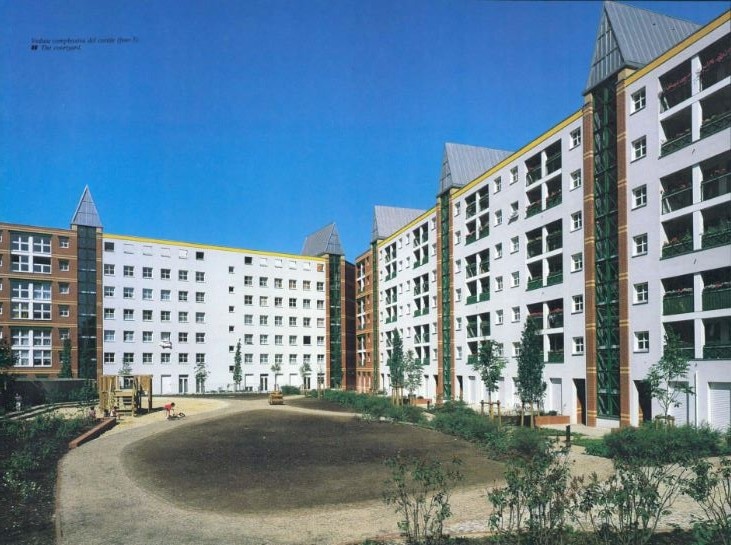
All this is enclosed by the continuity of the residential architecture which is always porticoed on the ground floor and open into the garden in the inner buildings. It is composed of brick and glass and green copper roofs, marked by elevator towers that look like pinnacles or spires. The reference to the Berlin masters (Mies and Schinkel), to the long buildings projected in the drawing of the Belle-Alliance-Platz, to certain attitudes towards the city, has become a unitary architecture. This architecture at either end of Wilhelmstrasse is marked by two large columns which serve as an urban landmark and can be seen as a reference to Filarete’s column in Venice, as an obelisk and distinguishing feature of the city.
Objectives for the competition area
All the factors considered here were treated as valid for the whole area. The closeness of the link between Südliche Friedrichstadt and the historical image of Berlin will depend on how much the following criteria are respected: continuity of street frontage, average height to allow the creation of perspectives interrupted by gardens and by the alternation of old and new, without having an excessive volumetry; streets with porticoes and shops or public places. The single blocks will be characterized by precise architectural elements and by the personalities of individual architects. Any fragmentation or exercise will produce not a city but a fairground.
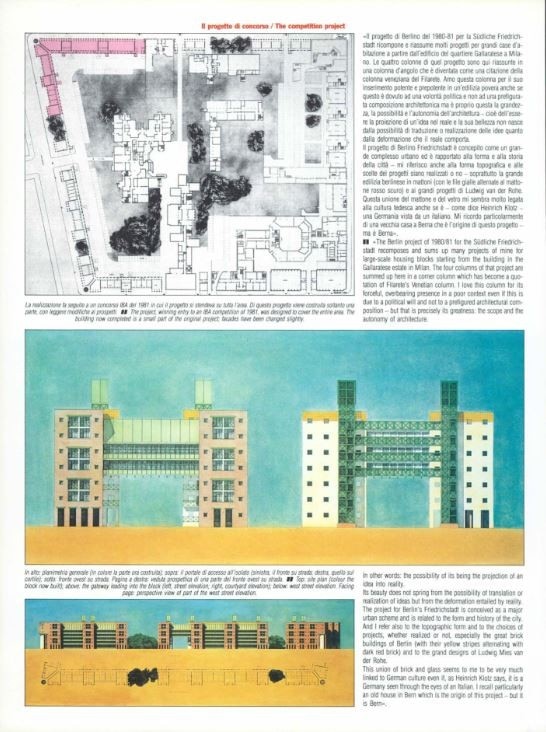
“The Berlin project of 1980/81 for the Südliche Friedrichstadt recomposes and sums up many projects of mine for large-scale housing blocks starting from the building in the Gallaratese estate in Milan. The four columns of that project are summed up here in a corner column which has become a quotation of Filarete’s Venetian column. I love this column for its forceful, overbearing presence in a poor context even if this is due to a political will and not to a prefigured architectural composition - but that is precisely its greatness: the scope and the autonomy of architecture. In other words: the possibility of its being the projection of an idea into reality. Its beauty does not spring from the possibility of translation or realization of ideas but from the deformation entailed by reality. The project for Berlin’s Friedrichstadt is conceived as a major urban scheme and is related to the form and history of the city. And I refer also to the topographic form and to the choices of projects, whether realized or not, especially the great brick buildings of Berlin (with their yellow stripes alternating with dark red brick) and to the grand designs of Ludwig Mies van der Rohe.
This union of brick and glass seems to me to be very much linked to German culture even if, as Heinrich Klotz says, it is a Germany seen through the eyes of an Italian. I recall particularly an old house in Bern which is the origin of this project - but it is Bern”.


